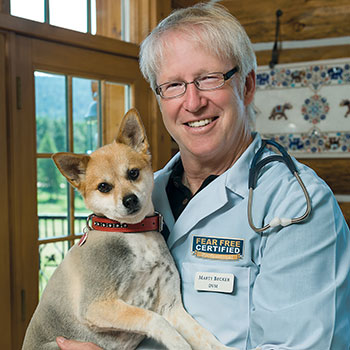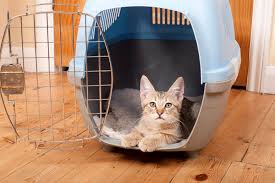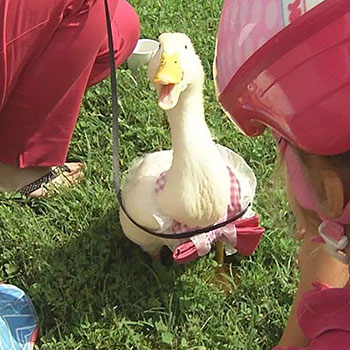Taking The Fear Free Movement Home
Dr. Marty Becker, Fear Free
 Many veterinarians are practicing "Fear Free," because pets that like going to the veterinarian are generally healthier. But that's not all, the Fear Free movement has come to your home with ideas for enriching your pet's life everyday. Dr. Marty Becker is back to explain how your pets can live an improved lifestyle.
Many veterinarians are practicing "Fear Free," because pets that like going to the veterinarian are generally healthier. But that's not all, the Fear Free movement has come to your home with ideas for enriching your pet's life everyday. Dr. Marty Becker is back to explain how your pets can live an improved lifestyle.
We have always been concerned with our pets' physical well-being. Now we need to also look at their mental well-being. This is where "Fear Free" comes in.
For far too long the veterinary professional has just been focused on physical well-being. This included things like vaccinations, parasite control, clean ears and short nails. When an animal was sick or injured, a vet would take care of them.
However, the emotional distress that an animal had was treated like collateral damage. Yes, the owner might have had to literally drag them in; and yes, the cat might fly out of the carrier like a furry jack-in-the box, but they got the job down not matter what it took. In other words, the end justified the means.
Stress for your pet is now on the downside with the "Fear Free Movement," which currently is an advisory group of over 175 people. There are only around 73-boarded veterinary behaviorists in the country and about 53 of them are part of this advisory group. Other people on the board include icons like Temple Grandin, the head of animal cognition at Duke, the head of animal cognition lab at Columbia, the head of animal cognition at Barnard and people that know about the non-human mind.
What they are doing is making veterinary care more like pediatric dentistry or pediatric medicine. This has changed so much from when we were younger and many of us were manhandled and manipulated, threatened and abused. Now, these offices are geared towards children to make them comfortable and relaxed to where they actually enjoy going. This is what they are doing for our pets.
For veterinarians, there is an online training program that they can take to make themselves and their office more fear free for their patients. When the Fear Free Movement started, they had hoped to get 1,000 veterinarians and veterinarian technicians the first year. Now years later, they already have over 18,000 signed up.
 Dr. Becker tells us a story about a Cur Hound named Clyde. It was Clyde's last day, as he was set to be euthanized. However there is a group back east called the Underhound Railroad, who took Clyde from the south to the north, to a shelter in Pennsylvania. When a police officer, who was severely injured during an arrest and was on full disability saw Clyde, she fell in love with him an adopted him on first sight. This woman then took Clyde through the necessary training to become an assistance animal, like picking things up from the floor, answering the door and bringing her the phone. She also went though the training to have Clyde become a certified therapy dog. So now Clyde is both an assistance animal for her and a therapy dog for others.
Dr. Becker tells us a story about a Cur Hound named Clyde. It was Clyde's last day, as he was set to be euthanized. However there is a group back east called the Underhound Railroad, who took Clyde from the south to the north, to a shelter in Pennsylvania. When a police officer, who was severely injured during an arrest and was on full disability saw Clyde, she fell in love with him an adopted him on first sight. This woman then took Clyde through the necessary training to become an assistance animal, like picking things up from the floor, answering the door and bringing her the phone. She also went though the training to have Clyde become a certified therapy dog. So now Clyde is both an assistance animal for her and a therapy dog for others.
However, as part of animal assisted therapy, before going in to nursing homes and hospitals, the animal must have a freshly groomed coat and short nails. The woman then took Clyde to her veterinarian, who she has been with for ten years, and asked them to trim Clyde's nails. She told them that it was very hard for her to do and they assured her that they could do it very easily.
They then took Clyde in the back while she waited. All of a sudden, she heard Clyde screaming, a scream she had never heard before. A few minutes later a technician came out drenched in sweat and looked shell-shocked. She handed her the leash and said Clyde does not like to have his nails trimmed and that it took four of them to do the job. She was then told that Clyde needs to go to a trainer. When she took Clyde to the car, he was covered in urine, feces, anal gland secretions along with the sweat of the people who held him down.
When she got home she called a trainer who had gone through the Fear Free Certification. She then decided to go to a local veterinarian who had also been Fear Free Certified.
Clyde went to the new vet office hungry, because they had really high value food rewards. They had turkey and cheese as well as bacon. Clyde got to go in and had a treat, while lying on a yoga mat infused with pheromones.
 Since they could gauge his weight, they gave him a small amount of sedative and he was perfectly relaxed. While they gave a pretzel stick with peanut butter on it, they trimmed his nails, and he never stopped wagging his tail. His owner couldn't believe it!
Since they could gauge his weight, they gave him a small amount of sedative and he was perfectly relaxed. While they gave a pretzel stick with peanut butter on it, they trimmed his nails, and he never stopped wagging his tail. His owner couldn't believe it!
This shows you the difference. A veterinarian office that continues to treat animals like their feelings don't matter and that they need to restrain them with whatever it takes, needs to either change or go out of business.
The Fear Free Movement is being practiced in many veterinary offices, but you can also practice this at home. There is also the "Fear Free Happy Homes" movement.
If you visit a Fear Free veterinarian and even though your dog or cat has a great visit at their office, unfortunately they can still go home and have fear and anxiety. "Fear Free Happy Homes," is reducing fear, anxiety and stress at home and also increasing enrichment activities.
For example, for cats, carriers can be left out around the house to become a natural part of the landscape, perhaps sitting out near inviting food or with the top off so that it becomes an intriguing box to investigate. This way, the carrier doesn't suddenly appear as a menacing object that's inevitably associated with a trip to the vet. For dogs, it may be things like basic training, daily walks and food puzzles to challenge their minds.
Visit Fear Free Happy Homes for tips on making your home fear free and to locate a Fear Free Veterinarian near you. Go to Fear Free Pets to become certified.
Listen and Explore the Fear Free Expert Series
Trapped In A Hot Vehicle
Steve Burdo, Contra Costa County Animal Services
 Your dog doesn't need to be in a hot car to suffer from heat exhaustion. Temperatures above 82 degrees are enough to cause a fatal reaction. Steve Burdo from Contra Costa Animal Services sat inside his Acura as temperatures soared about 115 degrees. He did this to bring attention to a California law that allows people to break into cars to rescue hot animals.
Your dog doesn't need to be in a hot car to suffer from heat exhaustion. Temperatures above 82 degrees are enough to cause a fatal reaction. Steve Burdo from Contra Costa Animal Services sat inside his Acura as temperatures soared about 115 degrees. He did this to bring attention to a California law that allows people to break into cars to rescue hot animals.
A California law that went into affect on January 1, 2017, basically allows people to take more direct action if they see an animal that is in distress in a car with very poor ventilation, windows barely cracked, on a very hot day. Essentially the law says you can take action to rescue that animal from the car.
There was a lot of confusion around this law. Some people thought you could just go up and break a window and they've satisfied the requirements. However, there are steps you have to take both before and after you take any action.
Steve wanted to build awareness about the law, because as an animal control agency for a county of over 1.3 million people, they were getting a lot of calls about animals that were locked in hot cars. Some people stated that they had already taken action. In some cases officers had to go out to either rescue or retrieve animals that died as a result of being in a hot car.
The protocol for the law is that would-be rescuers must meet several conditions, such as:
 - They must verify that the owner is not around and make a good faith effort to find them
- They must verify that the owner is not around and make a good faith effort to find them
- They must have reason to believe the animal is in imminent danger
- They must confirm that the vehicle is actually locked
- They first must notify local police, fire personnel or animal control officers
- They may not use more force than necessary to open the vehicle
- They need to also protect themselves in case an animal is frightened
- They must stay with the animal until emergency help arrives
Steve wanted to make a public service announcement by demonstrating what an animal experiences when trapped in a hot car. So he locked himself in a hot car on a hot day for about 20 minutes. He believes at it's hottest it got up to around 118 degrees inside the car, with about 99 degrees on the outside. Steve had plenty of rescue personal on hand in case something went wrong.
The idea behind the whole demonstration was to promote education and awareness that is going to save pet's lives. Steve said there have been celebrities and athletes that have done similar stunts. However, while you were getting that they were in the car for a period of time and it was hot, he wanted to go above and beyond that. He wanted to tell people what they could do to keep an animal safe if they see it in that situation, as well as knowing what kind of affect it has on an animal's body.
Steve believes that his demonstration was successful and received a good response. His main hope was that people actually took away the educational elements from it and that his office will receive fewer calls about animals in hot cars as a result.
Visit Website
If It Walks Like A Duck And Talks Like A Duck, Its Probably A Duck
Shellie Powell & Diva Duck
 Shellie Powell has an unusual pet. She is the proud guardian of "Diva," a pet duck that wears a diaper and shoes. Diva goes with Shellie everywhere, including Walmart, Target and PetSmart. Shellie even trained Diva the Duck to be a Therapy Pet.
Shellie Powell has an unusual pet. She is the proud guardian of "Diva," a pet duck that wears a diaper and shoes. Diva goes with Shellie everywhere, including Walmart, Target and PetSmart. Shellie even trained Diva the Duck to be a Therapy Pet.
Shellie Powell's daughters were graduating from high school and would soon be off to college, making her an "empty nester. " She decided it would be fun to hatch some duck eggs upon their graduation, which would give her something to look forward to.
She was fully prepared and already had homes for the ducks before they even hatched. She said you should never hatch duck eggs unless you already have homes for them or are going to keep all of them yourself. After hatching the duck eggs, Shellie became attached to one and decided to keep her and named her Diva Duck.
Diva is Shellie's first and only duck. She claims unless you can spend a lot of time with your duck, you shouldn't have just one. She says they're social animals like dogs are. That's why when you see ducks; you always see a group of ducks. Fortunately Shellie does not work outside her home, she is in and out all day and spends a tremendous amount of time with Diva.
Diva goes many places with Shellie in a pet stroller. Most people think she has a baby or maybe even a dog. But when they walk by her, they usually take a second look. They then want to find out about her and pet her.
 Diva's been to Barnes & Noble, PetSmart, Target, Walmart and to the mall. Of course Shellie prepares Diva for an outing by using a harness made for a duck, believe it or not, which holds a baby diaper. Diva also wears shoes. She doesn't wear them all of the time, they just help out if she is walking on a slippery surface. These shoes are made specifically for ducks to give them traction.
Diva's been to Barnes & Noble, PetSmart, Target, Walmart and to the mall. Of course Shellie prepares Diva for an outing by using a harness made for a duck, believe it or not, which holds a baby diaper. Diva also wears shoes. She doesn't wear them all of the time, they just help out if she is walking on a slippery surface. These shoes are made specifically for ducks to give them traction.
Shellie makes sure that she gets Diva out at least once a week in the public. This is because Shellie raised Diva to be a therapy duck. Unfortunately, there are currently no certification programs for therapy ducks. There was a national certification program for ducks that was in place until 2010, but was dropped because they stated there wasn't enough research. However, there is still one place in the nation that was certified under this old program (they were "grandfathered" in). Shellie talked to them regularly, to find out what she needed to do, so her duck was ready to be a therapy duck.
Shellie has made a photo book, called Diva's Rules, so when she takes Diva around kids she can read the book to them about different thing that Diva has done. Some of the things she's done are visiting a fire station. Shellie took a picture of Diva with a fire truck and fireman, and one of the rules from this is, "Diva says don't play with matches."
Her family also thinks she is a little "quacky." Her husband eventually got on board, but was a little concerned when she wanted a pet duck that she could take out in public and that would live in the house. Fortunately, her husband and Diva got along! Shellie told us that while Diva does come in the house, she does not sleep with her, but sleeps in a baby playpen.
Pet Flipping - Seven Tips to Safeguard Your Pet - Dr. Debbie
 Pet lovers beware of the disturbing criminal trend called "pet flipping." This is when a person steals a pet or takes ownership of a lost pet, and then sells the animal. Pets are typically sold on the Internet to make a quick profit. The American Kennel Club (AKC) reports a rise in pet thefts.
Pet lovers beware of the disturbing criminal trend called "pet flipping." This is when a person steals a pet or takes ownership of a lost pet, and then sells the animal. Pets are typically sold on the Internet to make a quick profit. The American Kennel Club (AKC) reports a rise in pet thefts.
Pet flippers most commonly target purebred dogs because they can fetch a high price, but even mixed breed dogs are at risk. Dogs are swiped from porches, fenced in back yards, dog parks, and cars. Some pet scams involve a person advertising as a pet sitter or trainer, who then disappears with your pet. Other scams involve someone who steals a pet and then responds to the lost pet ad, making money on rewards.
Top 7 Tips to Prevent Pet Flipping:
1. Don't Leave Your Pet Unattended
Avoid leaving your pet unattended, even in your own backyard. Don't leave your pet outside of stores or coffee shops. Tying your dog's leash up while you run that quick errand can give a thief the few minutes he needs to snatch your pet while you step away. Keep a watchful eye on your dog when visiting dog parks.
2. Get Your Pet Microchipped
A microchip is one of the best tools to reunite lost pets and serves as legal proof of ownership. Be sure to keep your contact information up to date with the microchip company.
3. Use GPS Collars
A GPS collar allows you to track your dog's movement minute by minute. These units can help you find your pet quickly if lost, but are of little use if a pet flipper removes the collar. I use the Tagg Pet Tracker for my dog and like that I can locate him to a precise location with my smart phone.
4. Get Your Pet Spayed or Neutered
Dogs that aren't spayed or neutered are especially prized targets to thieves since they are perceived as a money-making opportunity. Spaying and neutering also decreases the desire to stray and is good for your pet's health.
 5. Research Pet Services Carefully
5. Research Pet Services Carefully
Before signing on for pet sitting or dog trainer services, research the business person's reputation with the Better Business Bureau. Ask your veterinarian for a referral to a reputable pet professional. Request references before using a new pet service.
6. Buyer Beware
Be cautious when buying a pet online and only use reputable breeders. Check out a breeders standing with the AKC and breed clubs. Be wary of individuals that lack documentation of breeding or veterinary health care records.
7. Sign Up For Doggie Facial Recognition Apps
High-tech facial recognition technology is now available to identify and track down lost pets with services like Finding Rover. Use your iPhone to download the app. Upload your pet's photo in their database, and promptly notify Finding Rover if your pet is ever lost.
Pet flipping is so heinous because it exploits the cherished relationship between family and a beloved pet. Share this information with fellow pet lovers to spread awareness and halt this criminal trend.
Featured veterinarian known as "Dr. Debbie" on national pet radio program, Animal Radio. Ebook author of "Yorkshire Terriers: How to Be Your Dog's Best Friend"; "Pugs: How to Be Your Dog's Best Friend"; "Mini Schnauzers: How to Be Your Dog's Best Friend"; and "Shih Tzu: How to Be Your Dog's Best Friend." Dr. Debbie's books.
Visit Website
Animal Radio News - Lori Brooks
 Do You Know How Much Do You Spend Every Year on Your Pets?
Do You Know How Much Do You Spend Every Year on Your Pets?
You may not realize how much you spend on your pets every year, but collectively, early estimates predict Americans' spending on pet food, other supplies and vet visits could top $143 billion this year. Around $58 billion of that is spent on just pet food, with that number expected to continue soaring. According to research, half of all pet owners are opting for more "clean eating" options, of plainly put, higher quality/more natural pet food. But, it's not just food that we spend on; another hefty expense is vet care. The average dog owner spends $1,500 a year on surgical vet visits plus and extra $500 a year on routine check-ups. Now, if you are an average spender, your yearly boarding fees run about $750, you likely spend another $150 on grooming, $150 on vitamins and supplements and close to $100 a year on toys.
Can Kissing Your Pet Make You Fat?
We know pets help people get outside to play or walk them, which increases our physical activity. But what about other physical health benefits? In one study at UC San Diego, researchers worked with 17 lucky senior citizens who agreed to a chance to receive a dog - or not. The ones that chose a dog were undergoing months of regular health checkups in which their fecal samples were being studied to determine the difference in everyone's gut microbes. They looked for microbiome changes in response to less stress or decreased cortisol levels. Meanwhile, other researchers looked into the connection between having a pet and obesity. They too were interested in gut health and trying to find out if certain microbial swaps (such as a kiss or a lick with your pet) might help or hurt when it comes to weight problems in both pets and people. Evidence actually suggested heavier people have heavier pets, which some scientists believe could be due to microbial swaps from a human to a dog. It may sound far-fetched, but there were some early hints that "fat" microbe transfers are possible: Studies in the past few years suggested we can make mice fatter or thinner by transferring microbes from fatter or thinner people to them.
 Calf Looks Like Gene Simmons
Calf Looks Like Gene Simmons
Have you heard about the calf that was born in Texas that looked like reality star Gene Simmons from the 70's band KISS? She was a dead ringer for the singer in his KISS stage makeup! She was named Genie as a tribute to Simmons.
Scammer Targets Lost Pets
The number of pet related fraud cases is on the rise. One case was where a woman's cat mysteriously disappeared from the front porch where he would take his afternoon nap every day. The day after he vanished, the owner put up fliers all over her neighborhood, with her cat's picture and her phone number. Less than a week later, she received a call from a man who left a message asking if there was a reward for the cat's return and then another call from a man who claimed to have the cat. If you know this scam, they began texting or emailing over the next several days. The owner thought there was something odd and asked to see a picture of the cat. The man sent a photo of two cats and neither looked like hers. More than suspicious at this point, she Googled the pictures and found they were generic images on the Internet. The man then said she could get her cat back for $300 and offered to finance the payments for 8 months! She believes her cat was lost forever or at least knew that the scammer didn't have him. Police said the owner did everything right by asking questions and not sending any money.
 Cat Becomes Surrogate Mom To Hedgehogs
Cat Becomes Surrogate Mom To Hedgehogs
An unusual rescuer at a zoo in Russia saved eight orphaned newborn hedgehogs. At first, humans stepped up and tried feeding them. They tried bottles, syringes, everything, but the baby hedgehogs refused to eat until Muska the cat took a turn. She was nursing her kittens at the zoo but would sneak over to feed the hedgehogs. Muska's milk was enough to ensure all eight babies survived until they could feed on their own. Even so, Muska continued to treat the hedgehogs as her own kittens, even when they accidentally pricked her.
Your Pet Will Not Become Autistic From Vaccinations
Veterinarians in Brooklyn, N.Y., reported a growing resistance to vaccinating pets, which might have been rooted in the anti-vaccine movement that claimed the life-saving vaccines may cause autism in children, a theory that has been proven to be false. Some people even thought their pets could become autistic from getting their recommended shots. Hopefully, this thinking was localized in New York, because nearby in Pennsylvania and New Jersey there weren't any widespread reports of this fear to veterinarians who said a dog has never been diagnosed with autism. However, there was a study years ago by the American College of Veterinary Behaviorists who said they had found a similar condition in dogs. The study said it was 'autism like' but never said it was the same disorder.
 Listen to the entire Podcast of this show (#1240)
Listen to the entire Podcast of this show (#1240)





